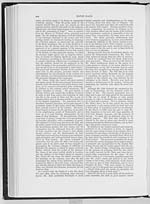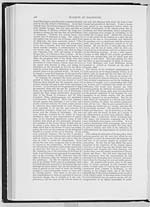Volume 1 > Half-Volume 2
(152) Page 425 - Dalhousie, James Andrew Brown-Ramsay, first Marquis of
Download files
Individual page:
Thumbnail gallery: Grid view | List view

425 from business pursuits. During this time he gave an hour or two daily to attendance at the bank, and the winding up of his own private concerns occupied an equal share of his attention; but at no period of his life were his public and private acts of benevolence, or his duties in the pastoral office, more attended to than at this time. For some months before Febru- ary, 1806, it was seen that his health and strength were failing. About the 1st of March of that year he was confined to bed, and died in peace on the 17th day of the same month, in the sixty-eighth year of his age, in his house, Charlotte Street, Glasgow. In his last illness he frequently expressed his confi- dence as resting on the fulness, freeness, and sim- plicity of the gospel truth which he had for so long a period preached to others. His remains were in- terred in St. David's Church burying-ground. No sculptured marble marks the place where all that is mortal of this good man reposes. The spot is indi- cated by a hewn stone built into the east boundary- wall, inclosed by an iron railing, about midway betwixt the south and north corner of the ground, having on it the following plain inscription:�"The burying-ground of David Dale, merchant, Glasgow, 1780." The establishment of the branch of the Royal Bank in Glasgow in 1783 proved to be of great service in promoting the trade of the city, especially in the manufacture of cotton goods, which made rapid progress from that date. Mr. Dale's management of the bank business was never objected to; he was discriminating and liberal in granting loans to the industrious prudent trader, while he had the firmness to resist the advances of the mere specu- lator. An anecdote has been preserved illustrative of his feelings and humanity towards an unfortunate individual who had committed forgery. A young man presented a draft for discount, which Mr. Dale considered to be a forged document; he sent for the young man, and in private informed him of his suspi- cions; the fact was acknowledged. Mr. Dale then pointed out to him the risk he put his life in by such an act, destroyed the bill, that no proof of his guilt should remain, and finding that he had been led to it by pecuniary difficulties, gave him some money, and dismissed him with a suitable admonition. In regard to his usefulness as a preacher of the gospel, the late Dr. Wardlaw used to say of Mr. Dale, that he was a most scriptural and instructive teacher of a Christian church. He had not acquired in early life a knowledge of the languages in which the Scriptures were originally written, but this lack was amply sup- plied by application in after-life. He could read with understanding the Hebrew and Greek; the Old and New Testaments were frequently, perhaps daily, studied by him in these languages. His public dis- courses were sententious. For several years before his death his pulpit services were listened to by many who came on purpose to hear his preaching. Various estimates of the fortune which Mr. Dale had realized were made about the period of his death; the probability is, that one and all were far wide of the truth. A vast amount of his effects consisted in mill buildings and machinery, which are of a very fluctuating value. A considerable part too was locked up in business concerns in operation, of which he was copartner, some of which were not closed for many years; and some of these proved to be very unprofitable. The exact, or even estimated amount, was never made known to the public; but it must, at the period referred to, have been very considerable. From the losses sustained in winding up, however, it is generally understood that a large portion was swept away, and that but a comparatively small part came ultimately to his family. DALGARNO, GEORGE, l an almost forgotten, but most meritorious and original writer, was born in Old Aberdeen about the year 1626. He appears to have studied at Marischal College, New Aberdeen, but for what length of time, or with what objects, is wholly unknown. In 1657 he went to Oxford, where, according to Anthony Wood, he taught a private grammar-school with good success for about thirty years. He died of a fever on the 28th of August, 1687, and was buried, says the same author, "in the north body of the church of St. Mary Magdalen." Such is the scanty biography that has been preserved of a man who lived in friendship with the most eminent philosophers of his day, and who, besides other original speculations, had the singular merit of anticipating, more than a hundred and thirty years ago, some of the most profound conclusions of the present age respecting the education of the deaf and dumb. His work upon this subject is entitled Didas- calocophus, or the Deaf and Dumb Man's Tutor, and was printed in a very small volume at Oxford in 1680. He states the design of it to be to bring the way of teaching a deaf man to read and write, as near as possible to that of teaching young ones to speak and understand their mother tongue. "In prosecu- tion of this general idea," says an eminent philosopher of the present day, who has, on more than one occa- sion, done his endeavour to rescue the name of Dal- garno from oblivion, "he has treated in one short chapter of a deaf man's dictionary; and, in another, of a grammar for deaf persons; both of them con- taining a variety of precious hints, from which useful practical lights might be derived by all who have any concern in the tuition of children during the first stage of their education" (Mr. Dugald Stewart's Account of a Boy Born Blind and Deaf). Twenty years before the publication of his Didascalocophus, Dalgarno had given to the world a very ingenious piece, entitled Ars Signorum, from which, says Mr. Stewart, it appears indisputable that he was the precursor of Bishop Wilkins in his speculations respecting "a real character and a philosophical language." Leibnitz has on various occasions alluded to the Ars Signorum in commendatory terms. The collected works of Dalgarno were republished in one volume, 4to, by the Maitland Club, in 1834. DALHOUSIE, JAMES ANDREW BROWN-RAM- SAY, first MARQUIS OF. This eminent statesman was born at Dalhousie Castle, county of Edinburgh, on the 22d of April, 1812. In point of antiquity, the family of Ramsay was conspicuous so early as the reign of David I., when Sir Alexander Ramsay, the knight of Dalwolsie, having signalized himself in the liberation of his country from England, was appointed warden of the middle marches of Scotland, and sheriff of Teviotdale. The envy of his great rival, Sir William Douglas, at this last appointment, and his attack upon the knight of Dalwolsie, while holding open court, and consigning him to a dungeon, where he died of hunger, is one of those terrible tales of ancient Scottish revenge with which our national history is only too abundant. Another distinguished member of the family was Sir John Ramsay, who saved the life of James VI., by stabbing the Earl of Gowrie, when the latter rushed into the king's apart- ment with a drawn sword, and at the head of his armed attendants, during the confused affray of what is called the Gowrie conspiracy. For this deed he was ennobled by the titles of Lord Barns and Vis- 1 I am indebted for this article to the Supplement to the Sixth Edition of the Encyclopedia Britannica; the only source from which I am aware that the information contained in it could have been derived.
Set display mode to:
![]() Universal Viewer |
Universal Viewer | ![]() Mirador |
Large image | Transcription
Mirador |
Large image | Transcription
Images and transcriptions on this page, including medium image downloads, may be used under the Creative Commons Attribution 4.0 International Licence unless otherwise stated. ![]()
| Biographical dictionary of eminent Scotsmen > Volume 1 > Half-Volume 2 > (152) Page 425 - Dalhousie, James Andrew Brown-Ramsay, first Marquis of |
|---|
| Description | Spine title: Half-Vol. II. Campbell to Erskine. |
|---|---|
| Description | Volume I. Contains names alphabetically from Abercromby to Erskine. |
|---|

